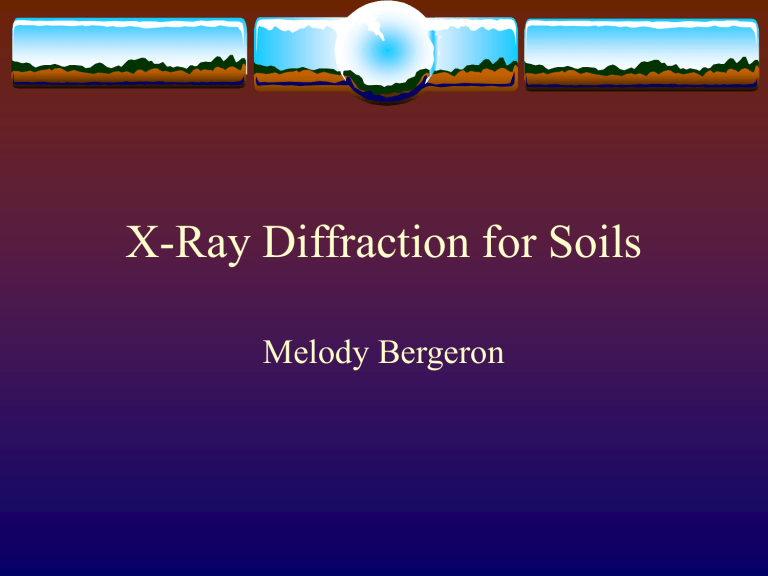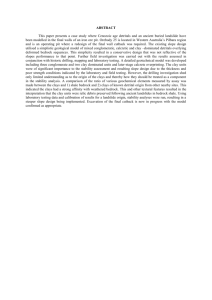X-Ray Diffraction for Soils: Mineral Analysis & Clay Properties
advertisement

X-Ray Diffraction for Soils Melody Bergeron X-Ray Diffraction Capabilities Crystallography How it works Sample Preparation Examples X-Ray Diffraction Mineral Identification Element Analysis independent of crystal size, small sample, “nondestructive,” mixtures Phases as little as 1-3% sample weight can be identified Qualitative or Quantitative Must be crystalline! Crystallography Unit Cell Crystals repeating structures Atoms form planes in the structure enstatite beryl albite fluorite Perkins, 1998 Planes in a crystal Diffraction based on λ of X-rays and plane spacing n http://pubs.usgs.gov/of/of01-041/htmldocs/xrpd.htm The X-ray Diffractometer Cu source, X-ray beam, interaction with specimen Detector records diffraction pattern at varied angles http://pubs.usgs.gov/of/of01-041/htmldocs/xrpd.htm Powder XRD Powder, crystals in random orientations Goniometer swings through many angles Enough crystals, enough angles, get enough diffraction to determine mineralogy http://pubs.usgs.gov/of/of01-041/htmldocs/xrpd.htm XRD of Soils and Sample Prep. XRD used for Identification of Components Silicates, Clays, Carbonates, Oxides, some organics?, etc… Need disaggregated, powdered samples for analysis – dry preferred Additional sample preparation is needed for detailed clay analyses Sample Problems Specific For Soils Methods depend on what question(s) you are asking Dry is preferred (bake at 100 ºC for 1 hr), but I have run wet samples for fragile clays Depending on the soil horizon - disaggregation may be difficult, organic material may need to be removed, cements may need to be dissolved Clays…if you see broader peaks in your pattern… Clay Prep. and Analysis Clay fraction needs to be separated (by size) for detailed analyses – mix sample in water, clays will be suspended, decant and centrifuge liquid to concentrate the clays Several methods for mounting the clays – need to orient them flat Tetrahedral Octahedral Tetrahedral Depending is needed on the type of clay, further preparation Clay Prep. and Analysis Methods include: Solvating with ethylene glycol or glycerol (replaces water – gives a constant interlayer spacing) Baking at various high temperatures to destroy parts of the crystal structure Saturating with cations (Mg, K, etc.) may produce diagnostic structural changes 14Å, 10Å, 7Å Clay Groups 14Å, 10Å, 7Å Clay Groups (shrinking-swelling clays) 14+Å, greater than 14Å if interlayer water Chlorite 14Å and 7Å peaks Kaolinite 7Å peak 10Å clays are Micas, Illite or Glauconite Vermiculite 14Å and ?Å depending on Mg, Na, Fe Sepiolite, Palygorskite, Halloysite… check for fibrous or tubular material in microscope first Smectites Additional Clay Problems Polytypes – many clay have several polytypes that may or may not be distinguishable in your diffraction pattern Interlayering – different types of clays can alternate (randomly or ordered ratios) producing a completely different diffraction pattern How important is it that you know exactly which clay you have present?... Determining Cations (for CEC)… Since changing cations may not alter the diffraction pattern, it is generally preferable to use EDX-SEM to determine the cations Examples Control – 16Å peak and small peak at 10Å EG Solvated 16Å shifted to 17Å Baked samples 16Å peak collapses to 10Å peak and small 5Å peak What clay is it? Go To Software Clay Mineralogy Surface charges on clays affect their absorption properties and their “engineering” properties Ex. some clays allows water into their inner layer and by doing so expand when wet and contract when dry Ex. other clay minerals exclude water from their inner layer Ex. Different clays bind different cations Cation Exchange Capacity… Cation Exchange Capacity The amount of exchangeable cations a soil or mineral is capable of retaining on its surface. Charge balance of overall mineral is required CEC - ∑Cations + ∑ Anions = 0 CEC= ∑Cations + ∑ Anions Calculation of Layer Charge and CEC for Montmorillonite (M0.33Si4 Al1.67 (Mg2+,Fe2+)0.33) Atom Z Si 4+ # ½ cell Total charge 4 16+ Al(VI) 3+ 1.67 5+ Mg or Fe2+ O 2+ 0.33 0.66+ 2- 10 20- OH 1- 2 Total layer charge 2- Formula weight for ½ cell of montmorillonite =359 g/mol Thus CEC of montmorillonite is 92 cmol/kg -22 -0.33 Interlayer Charge +0.33 (mol charge/mol 0.33 mol mol clay 1000 g 100cmol 92 cmol clay) * * * mol clay 359 g clay kg 1mol kg clay Clay Mineral Properties Type Group Formation Occurrence 1:1 Kaolin/ Serpentine Highly weathered soils kaolinite common in tropical env., serpentine rare, usually in coastal regions 0 none 0 Hydrogen bonds none except halloysite which has water 2:1 Pyrophyllite/ Secondary minerals Talc commonly found in metamorphic rocks pyrophyllite rare. Talc more common but susceptable to weathering 0 none 0 van der wahls none 65-80 2:1 Mica Primary mineral formed from melts common primary minereral in poorly weathered soils, often found in soils in large sheets, 1 none 0 strong electrostatic aproaching ionic Potassium 40-100 2:1 Illite Weathered Mica, K common intermediate 0.6-0.9, tetrahedra and weathered out, can be weaterhing product in soils usually closer octahedra, all precipitated from solution with mica to 0.8 dioctahedra some slight electrostaitc between K and other intrelayer cations K, Ca, Na, etc. intermediate hydration 60-200 2:1 Vermiculite A weathering product from common in many soils of mica, can be precipitated temperate regions from solution 0.6-0.9 tetrahedra and octahedral med-high 10-150 electrostatic force Ca, Na, Mg other between interlayer cations, if K then cations reverts to illite 600-800 2:1 Smectite A weathering product that very common in soils of precipitates from solution temperate regions 0.2-0.6 tetrahedra and octahedral high 80-150 electrostatic force Ca, Na, Mg other between interlayer cations,lots of cations water 600-800 2:1:1 Chlorite Formed in metamorphic environments rich in Fe and Mg. variable tetrahedral and some octahedral low 10-40 electrostatic and van der Wahls forces between 2:1 layer and hydroxide sheet 25-150 not commonly found in soils because interlayer easily weathered Charge per half cell Source of charge tetrahedra Shrink swell CEC cmol Force holding layers together kg-1 Interlayer cation brucite and gibbsite with isomorphic substution Total Surface area m2 g-1 7-30 From McBride 1994 Hydrated Cations in Interlayer From Schulze 2002 c-axis Spacing of Clay Minerals Structural Impacts on Clay Mineral Properties (1) Isomorphic substitution creates overall negative charge on clay layers. To balance charge cations are adsorbed in the interlayers. From Goldberg 2000 Structural Impacts on Clay Mineral Properties (2) Substitution originating in tetrahedral sheet leads to stronger sorption of some cations (e.g., K+) than isomorphic substitution in octahedral sheet. Shrink-swell characteristics of clay minerals are dictated by the layer charge. Edges of clay minerals have unsatisfied bonds and thus can form covalent bonds with sorbates Surface Functional Groups on Clay Mineral Edges Figure 5.3 from Sparks, 1995 Sorption to Mineral Surfaces Heavy metals, organics, etc. can sorb to many mineral surfaces If the mineralogy (and field conditions like pH, ppt, etc.) can be identified then the fate and transport of contaminants can be modeled Additional Information http://www.tulane.edu/~sanelson/eens211/x- ray.htm X-Ray Diffraction and the Identification and Analysis of Clay Minerals – Moore and Reynolds Minerals in general http://mineral.galleries.com/



